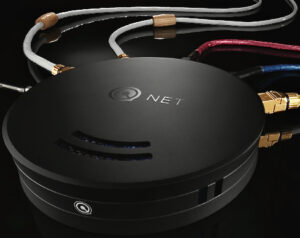
![]()
![]()
![]()
![]()
![]() The Audiophile switch upgrade
The Audiophile switch upgrade
Checking Nordost’s website, it was discovered the QNet is “a layer-2 Ethernet switch”—all Ethernet switches are layer-2 devices—“with five ports designed from the ground up with high-end audio performance and an extremely low noise operation in mind. And most audiophile switches on the market take an existing consumer-level switch and improve parts of it, typically the power supply and the clock. Also, while this approach certainly produces an improved performance, it doesn’t come close to the results achieved by a design conceived from the drawing board to transmit and receive high speed signals.”
With more silence came more beauty and detail—and with it, more light and spiritual insight. Also, Mental improvements can raise system performance from good or very good to great. And What’s more, occasionally a “small” change can cause a system to suddenly snap into focus; so, paradoxically, even a small change can be large. This claim seemed plausible, at least in the abstract. Everything in a system matters. And sometimes improvements are “large,” as in upgrading to a new DAC, server, amplifier, or speaker. Sometimes they’re “small,” as when a rack, cable, power product, or footer is replaced. I’ve put “large” and “small” in quotes because even small changes can have outsized importance in the impact the music makes.
QNet difference
Would the QNet would make a difference in unusually complicated Ethernet network? And convertinge Ethernet to optical and back again using three Small Green Computer/Sonore Optical Modules and an Uptone Audio EtherRegen. They, the router, Roon Nucleus+, and more all received power from HDPlex 300 four-device linear power supplies. And Gabor replied that I’d simply plug all those devices into the QNet Ethernet switch. Also, She also said that while the QNet would sound “really good” with its supplied switch-mode wall wart, it would sound even better with an optional QSource linear power supply (LPS).
The QSource, has four outputs fixed at 5V and two that are adjustable. Output A switches between 9V, 12V, or 19V; 9V is intended for the QNet. Output B switches between 12V, 19V, and 24V; 19V is appropriate for Roon Nucleus and Nucleus+ music servers. Also, The QSource’s fixed 5V outputs, which can provide very little power, are in- tended for Nordost QPoint Resonance Synchronisers. Those outputs can’t handle 5V devices that demand significant current. And Gabor said that the QSource sounds best with its premium QSource umbilical LEMO interface cables, which cost far more than the aftermarket Ghent Audio Canare umbilical interface cables used with the HDPlex 300. Audiophile switch
QSource
She was also certain that the QSource would produce better sound from the Roon Nucleus+ than the HDPlex 300 does—a bold statement from someone who, I’m guessing, has never heard the effects of an HDPlex 300. And Time to ponder. Undoubtedly, its Ethernet ports were sourced and assembled as cheaply as possible. Also, It seemed reasonable that better conductive materials and superior noise isolation might create a better-sounding network interface. And How much that would matter?
The QNet has five numbered Ethernet ports. Ports 1–3 are auto-negotiated 1000BASE-T (1Gbps) ports designed for routers and other “generic network devices.” Ports 4 and 5 are fixed, 100BASE-TX (100Mbps) “audio” ports for audio servers, players, and external media sources. Also, The QNet runs comfortably warm to the touch. Its innards are illuminated with a soft, pleasing blue light that’s only visible at certain angles. And The QSource runs quite hot. Also, It’s quite easy to accidentally flip one of the switches, which are located on the QSource’s bottom side. And If your QNet gets as hot as the QSource, disconnect immediately and check the switch.
Engineering
Electrical engineer Dennis Bonotto, senior R&D engineer and international sales rep at Nordost, supplied more information. And Bonotto played a key role in the engineering team that designed the QNet/QSource. Also, “97–98% of the audiophile switches on the market are mods of less noble switches, if you will,” he said. “Their different ports share some circuitry, terminations, and grounds, with soldering across and between the ports. And everything that happens on one port is heard by the other ports. Also, Some mount their oscillator clock on a daughter board and then run a cable between them. It may be better than the switch you buy at Wal-Mart, but it kinda defeats the point.
The Goal
“The main goal was to make the QNet as transparent and ‘not there’ as possible. And it was believed that by reducing or minimising the noise that is added into every single process that happens between signal entrance and exit—by tackling every single source of noise that might affect the signal going through the QNet can make a better, more silent device. Also, care taken to create five completely independent circuits, one for each physically separated port. And The shielding material on the ports is one piece folded; it’s not really soldered or joined. Also, The shield on each RJ45 is independently soldered to the board; then they connect → Read more
Please share with friends and colleagues if you enjoyed reading ‘Audiophile switch upgrade′.
Perkune audiophile cables 2023 I Professional audio